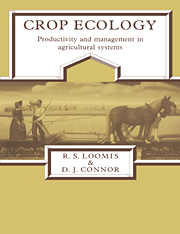Book contents
- Frontmatter
- Contents
- Preface
- Part I Farming systems and their biological components
- 1 Agricultural systems
- 2 Community concepts
- 3 Stability
- 4 Genetic resources
- 5 Development
- Part II Physical and chemical environments
- Part III Production processes
- Part IV Resource management
- References
- Species list
- Conversions and constants useful in crop ecology
- Index
5 - Development
from Part I - Farming systems and their biological components
Published online by Cambridge University Press: 05 June 2012
- Frontmatter
- Contents
- Preface
- Part I Farming systems and their biological components
- 1 Agricultural systems
- 2 Community concepts
- 3 Stability
- 4 Genetic resources
- 5 Development
- Part II Physical and chemical environments
- Part III Production processes
- Part IV Resource management
- References
- Species list
- Conversions and constants useful in crop ecology
- Index
Summary
INTRODUCTION
In plants, the numbers and types of organs produced are not defined in the embryo, as is the case in animals, but are determined later in variable response to environmental conditions. There are two parts to this. On the one hand, specific responses to temperature and daylength control the initiation of new organs, and on the other, more general environmental conditions determine the assimilate supply and hence the capacity for growth. The continuing change in plant form and function that results is called development.
Development involves the coordination and timing of the initiation, growth, and longevity of new vegetative and reproductive parts. Those new organs are initiated in meristems where their appearance is signaled by the formation of primordia, which are localized collections of meristematic cells. The subsequent change in size and form of those primordia (morphogenesis) to produce mature leaves or fruit, for example, is determined by the patterns of growth through cell division and enlargement and by specialization through differentiation of the cells and tissues.
The apical meristems of shoot and root have the capacity for unlimited growth and produce the continuously elongating body of the plant. The shoot meristem progresses in a special way with periodic production of new leaves at stem nodes separated from each other by internodes. Intercalary meristems in the internodes also contribute to shoot elongation, new apices in the leaf axils (axillary meristems) provide branching while lateral meristems, mainly vascular cambia, increase girth.
- Type
- Chapter
- Information
- Crop EcologyProductivity and Management in Agricultural Systems, pp. 104 - 128Publisher: Cambridge University PressPrint publication year: 1992



